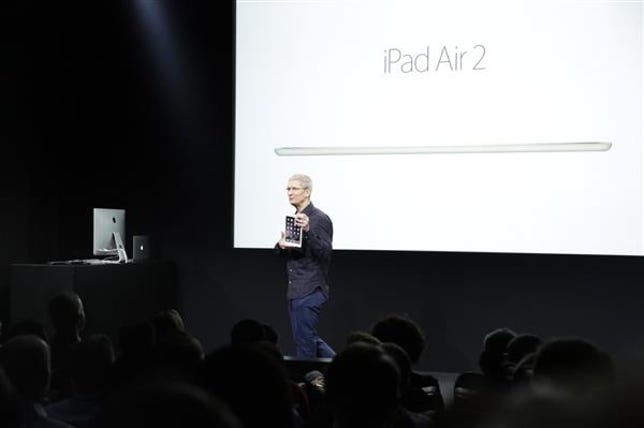
Tim Stevens/CNET
CUPERTINO, Calif. — Apple had plenty of iPad news on Thursday, but there was one glaring exception: the long-rumored iPad Pro.
Apple had been rumored for months to be working on a bigger tablet, likely with a 12.9-inch
display. While some reports had the company releasing the device this year, the fact that Thursday’s event came and went without any mention of an iPad Pro suggests the company is holding off until next year.
With the growth in the tablet market slowing, a larger iPad Pro could have shaken things up, giving businesses and power users a reason to buy a new device. While the iPad remains the top-selling tablet franchise in the industry, Apple has seen declining shipments over the last few quarters. The minor tweaks included in the iPad Air 2 and iPad Mini 3
aren’t likely to send customers to stores in droves (beyond the first-day lines, of course).
In Apple’s fiscal third quarter that ended June 28 — the most recent period the company has reported — iPad sales dropped 9 percent from a year earlier to 13.3 million. That fell short of analyst estimates and marks the second quarter in a row that demand has declined. While sales should jump back up during the holiday-shopping season, Apple may still struggle to surpass the mark set a year ago.
One thing analysts say could get people excited about the iPad again is a bigger version of the device. In particular, expected multitasking and split-screen capabilities in a larger device could appeal to business users who need to do several tasks at once.
Many big businesses have been scooping up hybrid devices that convert between tablets and laptops. Apple doesn’t offer such a device, and it doesn’t look like it will make a hybrid product anytime soon, not even with the iPad Pro as some had hoped. Two years ago, Apple CEO Tim Cook famously compared hybrids to combining a toaster and a refrigerator. But market watchers believe the iPad Pro will pair well with keyboards to serve as an alternative to a full-fledged computer.
“I think it makes complete sense for Apple to do that,” said Kris Perpich, co-founder and chief experience officer of Adonit, a 180-person company that makes styluses for iPads and other touch-screen devices.
Many business-oriented features, including those requiring styluses, become even more useful on bigger screens, Perpich said. And an iPad Pro would help Apple keep its ecosystem advantage when it comes to design and drawing apps, he added.
“They have a lot of developers there, and they’re making developers a lot of money,” Perpich said, and those developers would be eager to follow Apple into the market for a larger, more powerful iPad.
Apple’s October 16 event (pictures)






But there are a few reasons why Apple may be postponing the iPad Pro until 2015. First are manufacturing and production issues. Apple already has trouble fulfilling orders for its 5.5-inch iPhone 6 Plus, with customers typically waiting about a month to receive their phone-tablet hybrid. That device and its smaller sibling, the 4.7-inch iPhone 6, have been posting record sales since their launch last month — something that means still-long wait times.
Apple may be dedicating more factories to the new iPhones than to its other devices to address that demand, and there could be issues associated with building them.
“There are only so many production lines you can put in place,” Gartner analyst Van Baker said. “You don’t want to roll out a product and have constrained supply or push availability for a product that’s already constrained.”
The timing may also have something to do with the software. Adding split-screen multitasking or other features for bigger screens may be more difficult than Apple anticipated. And the company may be focusing first on getting iOS 8 fixed and Mac OS X Yosemite to market.
Apple could also be waiting for its recent partnership with IBM to ramp up. The two companies reached a deal in July to work together on tailoring Apple devices and iOS apps to business users. IBM’s cloud computing services — such as device management, security and analytics — also will be optimized for iOS.
“Maybe they’re waiting to really have something in place with IBM, so they know what they’re doing and can hit the ground running,” Kantar Worldpanel analyst Carolina Milanesi said.
Most of all, the delay could be a matter of strategy. For the past couple of years, all of Apple’s major products have hit the market in the fall. The company tends to show off its newest iPhones in September and launch its newest iPads a month later. Together, the two mobile devices account for two-thirds of Apple’s sales. The company benefits from the holiday-shopping season, but that puts a lot of pressure on the end of the year and means other times of the year are weaker.
“Apple suffers from the fact all devices come out in the fall,” JackDaw Research analyst Jan Dawson said. “If it puts some releases in the spring, it can alleviate some of that.”
And a business-oriented product like an iPad Pro doesn’t necessarily need the sales boost that’s inherent in the holiday season, which is more of a consumer phenomenon.
Apple also may be spreading out the launch to give its smaller iPads and Mac computers some breathing room to take off.
Apple’s tablet sales won’t crater as people wait for a bigger iPad. But Apple may be missing out on a chance to inject a little excitement back into the tablet business.
CNET’s Stephen Shankland contributed to this report.



